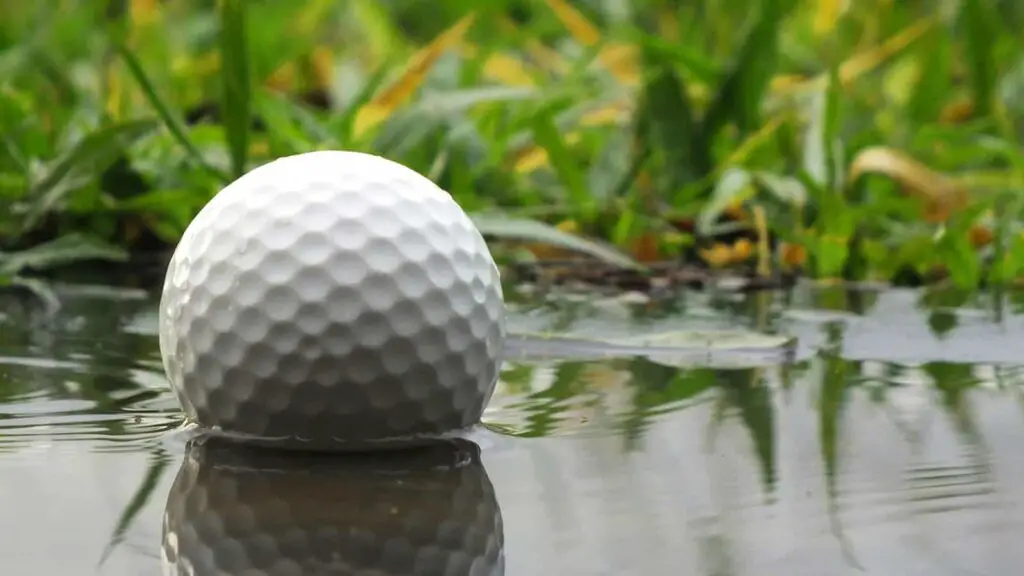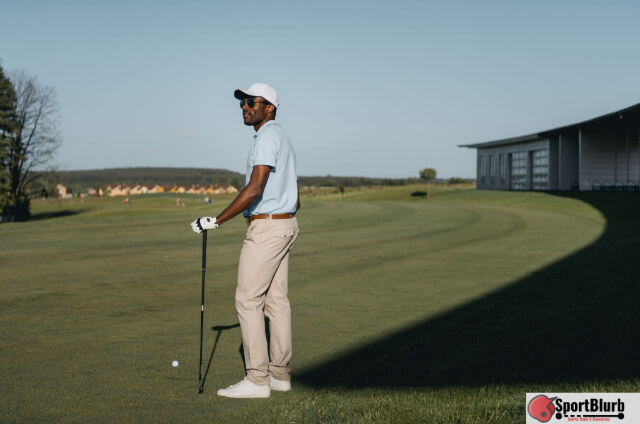Last Updated on October 26, 2023 by Alex PT
No, golf balls do not go bad in water. Golf balls are designed to be water-resistant, and they can be submerged in water for extended periods of time without being damaged. However, if a golf ball has any cracks or cuts, water can seep inside and affect its performance.
This Table Consists Of All The Information Concerning The Golf Balls.

| Parameters (In Question Form) | Answers |
| Do Golf Balls Go Bad Over Time (If Used)? | If golf balls are extremely scratched up, they can go bad. The performance of a golf ball in terms of roll, flight, distance, and spin can be really affected when it hits solid objects like cart paths, trees, and even clubs repeatedly |
| How do you prolong golf balls lifecycle? | You should ensure that they are washed and cleansed from the scuffs on them with the magic eraser brush. Furthermore, proper storage is an important factor to be considered to prolong the life of your golf balls. |
| Do Golf Balls Go Bad in Water? | Yeah! If golf balls can sit down in the water for over twelve hours, it is going to be completely damaged. |
| Do Unused Golf Balls Go Bad? | Unused golf balls have the ability to last for 10 years if they are stored at room temperature around 70-80 degrees. |
| Do Urethane Golf Balls Go Bad? | They are tough, durable, and can last for years if kept in mint or new condition. |
| Do Pro V1 Golf Balls Go Bad? | The recent Titleist Pro V1 golf balls can be preserved for more than five years in as much as they are not exposed to excessive heat. |
Do Golf Balls Go Bad In Water?
Whether or not a golf ball goes bad in water depends on a few factors, including the construction of the ball, the length of time it is submerged, and the temperature of the water.
Construction
Golf balls are typically made of three layers: a core, a mantle, and a cover. The core is the heaviest layer and gives the ball its weight and distance. The mantle is a softer layer that helps to compress the core and generate spin. The cover is the outermost layer and protects the ball from damage.
Most golf balls are designed to be water-resistant. The cover is made of a material that prevents water from seeping inside the ball. However, if a golf ball has any cracks or cuts in the cover, water can seep inside and damage the core and mantle.
Length of time submerged
The longer a golf ball is submerged in water, the more likely it is to become damaged. If a golf ball is submerged for more than a few hours, water can start to seep inside the ball and damage the core and mantle.
Temperature of the water
The temperature of the water can also affect how quickly a golf ball becomes damaged. Golf balls are more likely to be damaged in warm water than in cold water. This is because warm water causes the air inside the ball to expand, which can put pressure on the cover and cause it to crack.
Overall
While golf balls are designed to be water-resistant, they can become damaged if they are submerged for extended periods of time, especially in warm water. If you find a golf ball in the water, it is best to dry it off before using it again. If you see any cracks or cuts in the ball, it is best to replace it.
Here are some tips for keeping your golf balls in good condition:
- Avoid submerging your golf balls in water for extended periods of time.
- If you do find a golf ball in the water, dry it off as soon as possible.
- Inspect your golf balls for cracks or cuts before using them.
- Replace any golf balls that are damaged.
Do Golf Balls Go Bad Over Time (If Used)?
Golf balls can deteriorate over time if they are used frequently or stored improperly. Here are the factors that contribute to the degradation of golf balls:
- Ball Construction: Golf balls are typically made with a core, mantle, and cover. The quality of these components can affect a ball’s longevity. High-quality, multilayer balls are less likely to degrade quickly.
- Use and Impact: Repeatedly hitting a golf ball can cause the cover to develop scuffs, scratches, and cuts. This wear and tear can negatively impact the ball’s performance.
- UV Exposure: Exposure to ultraviolet (UV) rays from the sun can lead to discoloration and the breakdown of the ball’s materials. Over time, this can affect the ball’s compression and feel.
- Temperature Extremes: Extreme heat or cold can impact the elasticity of the ball’s core and cover. Balls left in a hot car or in freezing conditions may not perform optimally.
- Water Exposure: Golf balls submerged in water can absorb moisture through the cover, which affects their weight and balance temporarily. However, they can often be dried and reused.
- Storage Conditions: How golf balls are stored matters. Keeping them in a cool, dry place can extend their lifespan, while exposure to humidity or extreme temperature fluctuations can accelerate degradation.
- Ball Age: The age of a golf ball, even if unused, can affect its performance. Manufacturers typically provide recommendations on the shelf life of their golf balls.
- Compression: Over time, the compression of a golf ball can change, impacting its feel and distance. However, this typically takes several years of use.
- Distance and Accuracy: As golf balls age and wear, they may lose some distance and accuracy. This can be a significant concern for professional or highly skilled golfers but less so for casual players.
How Do You Prolong The Golf Balls’ Lifecycle?
To prolong the lifecycle of your golf balls and maintain their performance, follow these tips:
- Proper Storage:
- Store golf balls in a cool, dry place away from direct sunlight and extreme temperature fluctuations. A moderate temperature helps preserve ball materials.
- Keep Them Clean:
- Clean your golf balls after each round using warm, soapy water and a soft brush. This prevents the accumulation of dirt and debris that can affect performance.
- Avoid Water Hazards:
- Minimize hitting golf balls into water hazards to prevent water absorption. Wet balls can be dried and reused, but their performance may be temporarily affected.
- Use a Ball Retriever:
- When practicing, consider using a ball retriever to collect golf balls from hazards without having to wade into water.
- Rotate Golf Balls:
- Rotate your golf balls during rounds or practice sessions to distribute wear and tear evenly among them. This ensures longer-lasting performance.
- Choose the Right Ball for Your Game:
- Select a golf ball that matches your skill level and playing style. High-quality, multilayer balls may last longer and offer consistent performance.
- Avoid Hitting Cart Paths and Rocks:
- Minimize striking the ball against hard surfaces like cart paths and rocks, which can cause cuts and abrasions to the cover.
- Inspect for Damage:
- Regularly inspect your golf balls for visible damage, such as cuts, scuffs, or cracks. Replace any balls showing signs of significant wear.
- Buy in Bulk:
- Purchasing golf balls in bulk can be cost-effective and ensures you always have a fresh supply available.
- Use Ball Markers:
- Mark your golf balls for easy identification. This can help you track the performance and durability of specific balls over time.
- Manage Impact:
- Work on improving your swing mechanics to avoid striking the ball with excessive force, which can contribute to quicker degradation.
- Resist the Urge to Overclean:
- While cleaning is important, avoid overcleaning golf balls, as excessive scrubbing or harsh chemicals can erode the cover.
- Consider Hybrid or Urethane Balls:
- Urethane-covered balls tend to be more durable and suitable for avid golfers, but they may be pricier.
- Keep Ball Boxes Intact:
- Maintain the original packaging of unused golf balls to protect them from dirt and moisture.
- Recycle or Donate Old Balls:
- Consider recycling old golf balls or donating them to junior golf programs or driving ranges to extend their useful life.
Do Unused Golf Balls Go Bad?
Unused golf balls have the ability to last for 10 years if they are stored at room temperature around 70-80 degrees. Golfweek.com once said that a golfer would not be able to tell the difference between a new ball stored for years and a new ball off the shelf. Their performance will be similar unless the other has been stored for more than 100 years.
Do Urethane Golf Balls Go Bad?
If you’re an avid golfer you would notice that the most common outer layer of golf balls available on the market are the Urethane golf balls. They are tough, durable, and can last for years if kept in mint or new condition. However, if you get them scuffed up or left inside the ponds, they’ll definitely lose their performance.
Do Pro V1 Golf Balls Go Bad?
If you’re talking about four-piece golf balls that are highly priced with outstanding features like high-spin, long-distance, and complex build around the golf course. We all heard about golf ball researchers at Titleist said that the recent Titleist Pro V1golf balls can be preserved for more than five years as long as they are not exposed to excessive heat.
Closing Thoughts
If golf clubs are not stored in bad conditions like extremely hot or cold temperatures, water-logged, or scuffed up, they should last for years. Once again, If golf balls can sit down in the water for over twelve hours, it is going to be completely damaged. Although it may be hard to observe from the outside, the destruction caused will evidently impact the driving distance off of the tee. Moreover, the golf ball’s center is harmed and that is designed to be the cause in case the ball’s energy. We’ve come to the end of the article. We hope you love every bit of it. Please do not hesitate to contact us with any questions or comments.
References:
https://honestgolfers.com/do-golf-balls-get-waterlogged/
https://southamptongolfclub.com/do-golf-balls-get-waterlogged/

Hi! I’m Alex PT. I hold a Bachelor’s degree in Sports Management from Indiana University and have over seven years of valuable experience working in a Sports Event Management Company. I founded SportBlurb with the passion for bringing you the latest, most insightful, and engaging content in the world of sports. So, whether you’re a die-hard fan or want to stay informed, I’ve got you covered!

